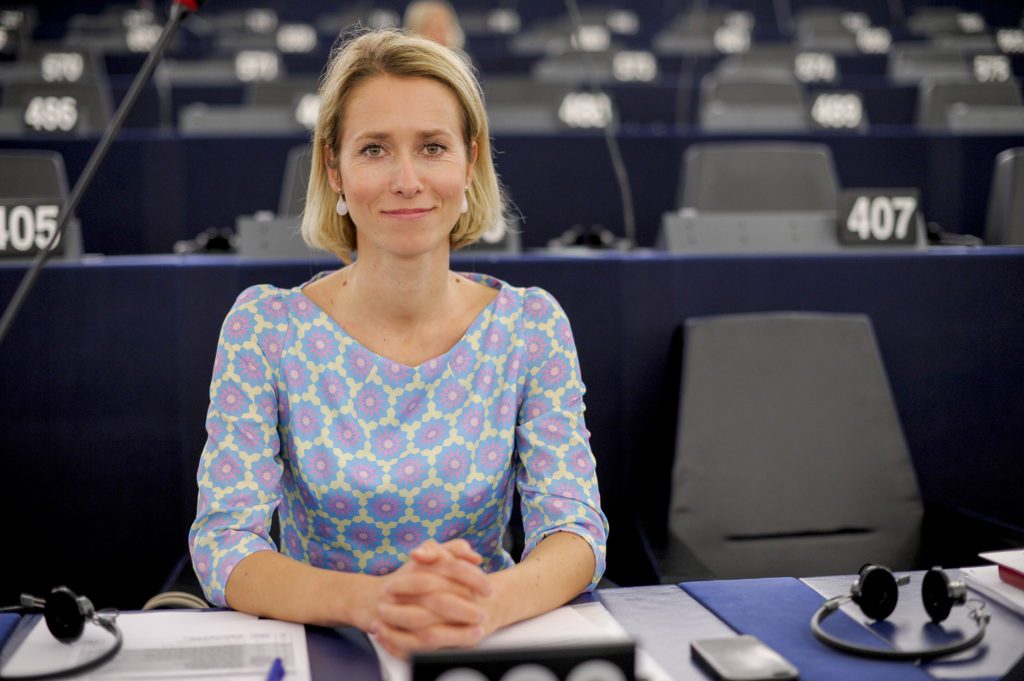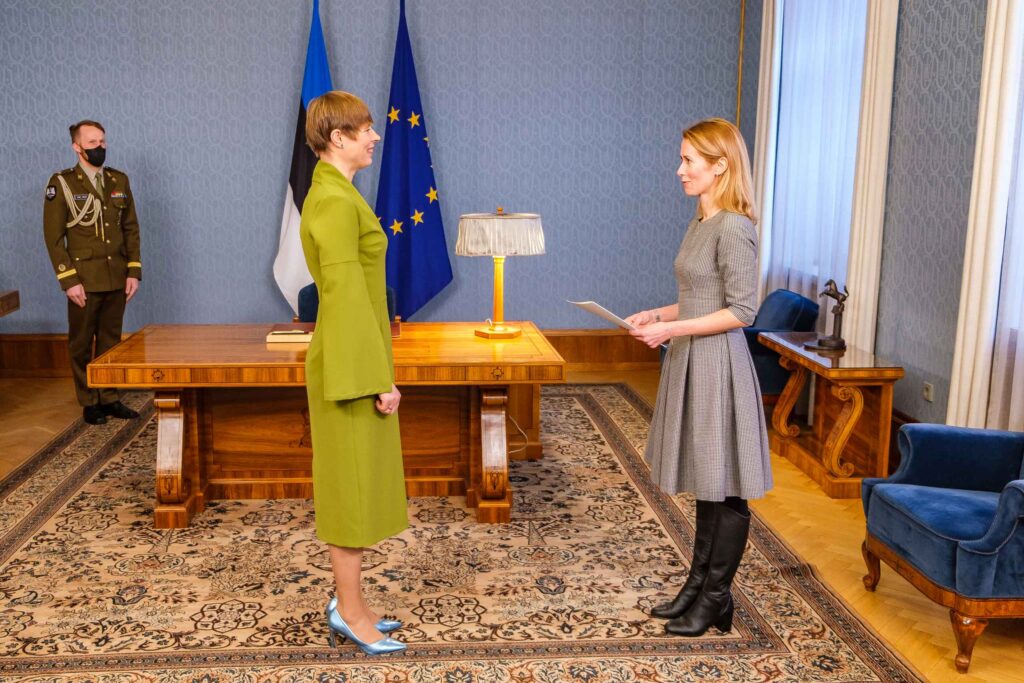Kaja Kallas, the leader of the Reform Party, has become Estonia’s first female prime minister; Estonia would thus currently become the only country in the world where both the president and the prime minister are women.
Kaja Kallas was nominated to form the government by the Estonian president, Kersti Kaljulaid, on 14 January – after the previous governing coalition, led by the Centre Party, collapsed.
The Reform Party, led by Kallas, won the 2019 parliamentary election in Estonia with 34 MPs in the country’s 101-seat parliament, Riigikogu. However, the second most successful party in the election, the Centre Party – led by Jüri Ratas – went ahead and formed the government, instead.
In April 2019, with 25 MPs in the parliament, Ratas’s party formed the coalition with the conservative Isamaa Party (12 MPs) and the far-right and populist Estonian Conservative People’s Party, also known as EKRE (19 MPs) – the decision of which received a widespread criticism in Estonia and abroad. Since then, Ratas’s government experienced many scandals, mainly due to the outspoken EKRE leaders, father and son Mart and Martin Helme.
A chance to form the new government
Ratas’s coalition government collapsed after the Estonian Public Prosecutor’s Office announced on 12 January it suspected the Centre Party and five individuals, including the party’s secretary-general, Mihhail Korb, were involved in a corruption case. Ratas, who had been Estonia’s prime minister since November 2016, announced his resignation on 13 January. Meanwhile, the Centre Party said it would not lead the new government, effectively handing the role to the Reform Party.
In the immediate aftermath, many expected the Reform Party to form the new coalition government with the Social Democrats and Isamaa (the three parties were previously in the coalition from 1999-2002), but the party entered in talks with the Centre Party instead. This decision faced a moderate criticism as the Centre Party – the party of which has faced more corruption scandals over the years than any other in Estonia – is yet again suspected of a criminal activity.

Kallas reasoned her party’s decision on favouring the Centre Party above others, by arguing that Isamaa’s current leadership had been hostile towards forming the government with the Reform Party, instead preferring to continue with the previous coalition. However, Isamaa’s leader, Helir-Valdor Seeder, has rejected this claim, saying the Reform Party never approached them.
More female ministers than ever
Following the negotiations, by 24 January, the Reform and Centre Party agreed on the principles and programme of the new government and announced the names of the new 15-strong cabinet.
In addition to the prime minister’s position, the Reform Party will fill the positions of the finance (Keit Pentus-Rosimannus), justice (Maris Lauri), social protection (Signe Riisalo), education and research (Liina Kersna), foreign trade and IT (Andres Sutt), rural affairs (Urmas Kruuse) and defence (Kalle Laanet) ministers.

The Centre Party’s politicians will assume the duties of the social affairs (Tanel Kiik; he held the same position in the previous government), economic affairs and infrastructure (Taavi Aas; also held the same position), internal affairs (Kristian Jaani), foreign affairs (Eva-Maria Liimets; this is the first time the party holds the foreign minister’s position), culture (Anneli Ott), environment (Tõnis Mölder) and public administration (Jaak Aab) ministers.

It is notable that including Kaja Kallas, the new government will have seven female ministers (46,7% of the cabinet) – a record in Estonia so far.
Many Estonian analysts have predicted that the new government will not have a chance to introduce ground-breaking or sweeping reforms before the next parliamentary election, due to take place in March 2023.
Rather, it is dubbed as the “crisis government”, since it needs to alleviate Estonia’s economic situation, hit by the consequences of the coronavirus pandemic. The country’s health-care system is also struggling to cope with the ongoing crisis and Estonia – like the other member states of the European Union – has been slow in vaccinating its population against the virus.
Both the Reform Party and the Centre Party are liberal on paper – both belong to the Alliance of Liberals and Democrats for Europe (ALDE) – but not necessarily in practice. In the past, the Reform Party has demonstrated national conservative tendencies and the Centre Party has stood out for a number of populist initiatives over the years – not to mention it was the party that formed the previous government with the polarising, far-right, EKRE. The Centre Party’s cooperation agreement with Russia’s ruling party, Vladimir Putin’s United Russia – signed by the party’s deputy leader Mailis Reps in 2004 – has not been annulled either.
Who is Kaja Kallas?
Kallas was born in 1977 in Tallinn and comes from a prominent family. Her dad, Siim Kallas, became active in the Estonia’s independence movement in 1987 (he was one of the four authors behind the idea for self-managing Estonia, IME, while the country was still occupied by the Soviet Union) and was one of the founders of the Reform Party. He also served as the country’s prime minister (2002-2003) and as a European Commissioner (2004-2014).
Kaja Kallas has a law degree from the University of Tartu and a master’s degree in business administration from the Estonian Business School. Before entering the frontline politics, she worked as a lawyer.

In 2011, Kallas became a member of the Reform Party and in the same year, was elected to the Estonian parliament, where she chaired the Economic Affairs Committee until 2014. She also published a blog and became well known for an occasional criticism of her own party, at the time led by Andrus Ansip.
Standing out as a MEP
In 2014, she was elected to the European Parliament, where she worked on the EU’s digital single market strategy, energy and consumer policies, as well as on relations with Ukraine. Prior to being elected, Kallas told in an interview with Estonian World the EU still had too many barriers in the internal market.
In 2019, the Politico magazine picked her as one of the 40 members of the European Parliament “who mattered in 2014-2019” – the previous term of the legislative body of the European Union. “A competition lawyer, Kallas shone brightly in her time as a MEP, developing a high profile on the tech brawls that came to dominate the Parliament’s agenda,” Politico said.

Kallas also published a book in Estonian about her life and work in Brussels from 2014-2018.
Return to domestic politics
By late 2017, the Reform Party was in turmoil. A year before, the party had been forced into opposition, when the Centre Party, Isamaa and the Social Democrats formed a coalition – first time since 1999 when the Reform Party was not part of the government.
Taavi Rõivas, Estonia’s prime minister from 2014 until 2016, had resigned as the party’s leader and the subsequent leadership contest was won by Hanno Pevkur. However, conflicts within the party forced Pevkur out. In December 2017, he announced he would no longer run for party leadership in January 2018 and suggested Kaja Kallas should run instead – she did and became the party’s first female leader.
Kaja Kallas gave up her European Parliament seat and led the Reform Party to the election victory on 3 March 2019 – the party won about 29% of the vote, while the ruling Centre Party took about 23% of the vote. She was then expected to become the prime minister – instead, the Jüri Ratas-led Centre Party was still able to form a governing coalition with Isamaa and EKRE that lasted until 13 January 2021, when it collapsed. Now, it was finally her turn.

As it stands, Estonia would be the only country in the world where both the prime minister and the president (Kersti Kaljulaid became Estonia’s first female president in 2016) are women. There are only three other countries where the prime minister and the head of state are both women – New Zealand, Barbados and Denmark. However, the heads of state of the three are monarchs (Elizabeth II in the first two and Margrethe II in Denmark).
The new Estonian government, led by Kaja Kallas, is expected to assume duties on 26 January, subject to the parliamentary approval. Together, the Reform Party and the Centre Party will have a comfortable majority of 59 MPs in the 101-seat parliament.
Read also: Kristi Raik: Liberal Estonia is back – but mainstream parties need to learn their lessons.
Cover: Kaja Kallas. Photo by Stina Kase.

